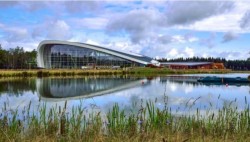Awards celebrate timber in design and aim to acknowledge excellence in wood usage and innovation.
Center Parcs Ireland has been declared overall winner in Wood Awards Ireland 2020 for its innovative use of a wide variety of woods in the construction of its holiday resort near Ballymahon, Co Longford.
Completed by John Sisk & Son and designed by Holder Mathias Architects, this large-scale leisure project "explored wood in all its forms from solid timber to engineered wood comprising glulam (glued laminated timber) and cross laminated timber", according to the judges.
The development includes 466 self-catering lodges and 30 apartments. Imported wood was in rough sawn format which was then manufactured in an Irish sawmill to a wide range of different sizes. Once machined, the wood was treated with wood preservative to increase its durability and lifespan. The range of timber used included Norway Spruce; European Larch, Western Red Cedar, Siberian Larch, Elliotis Pine and Bangkirai.
The annual awards presented by Forest Industries Ireland (FII) with the Royal Institute of the Architects of Ireland are a celebration of timber in design and aim to acknowledge excellence in wood usage and innovation. It showcases exemplary timber design projects and highlights the benefits of utilising timber in the built environment to reduce environmental impacts.
FII director Mark McAuley said "Wood is a beautiful material and it lends itself to beautiful design. We produce a lot of timber in Ireland and its applications in the built environment are endless. The world is entering a timber revolution and we hope to see many more architects and designers focussing their talents on the medium of wood."
Minister of State Pippa Hackett who attended an online awards event on Friday commended the winners. "I really do appreciate the role that trees, and the wood it produces, can play in our society and economy. Trees really matter for our environment, our biodiversity, and for climate action, but also for the production of timber," she added.
The small scale private building winner was Pavilion House – a renovation of an existing 1950s bungalow designed by Robert Bourke Architects using Douglas Fir, Birch and European Oak.
Alan Meredith was the furniture winner for his Vinculum Series made from Ash and Irish Oak. The judges commended his creation of functional surfaces that merge directly into the structure of the piece. Its common thread was the use of steam bent sections of wood.
The student award went to Eoghan Smith of UCD School of Architecture who modelled a development for Merrion Square, Dublin, with a view to fostering "an inclusive and participatory relationship between the city's architecture and its citizens".
Departure
Taking the Irish Citizens' Assembly as a point of departure, his thesis imagines a site in the city where public participation in the Irish democratic process is given physical and symbolic status in the form of a new citizens' assembly building. The Assembly Room is elevated in a timber, tensile structure which draws from the language of temporary festival tents and stadiums – buildings where a clear articulation of the assembly of structure becomes representative of the assembly of people.
A new public plaza is proposed which claims land from the gated lawn of Leinster House, and connects the entrances of the National Gallery, the Natural History Museum and the new Assembly Building. The building's structure opens out towards the park and the new square to form stages, creating an infrastructure for performance and demonstration.









